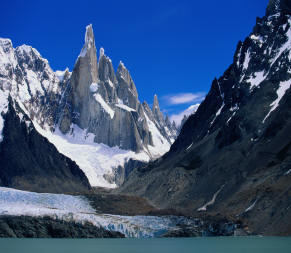|
||||||
|
Regions
North East
This is a region of large rivers, humid tropics, red earth, magnificent forest, a virgin forest full of huge trees and extraordinary flora and fauna. Great Waters – “Iguazú” in the Guaraní language – overflowing into one of the world’s wonders: the Iguazú Falls.
A scenery of exuberant beauty spreading along the Iguazú National Park, Saltos del Moconá (Moconá Falls), Río Pilcomayo National Park, El Palmar National Park, Esteros del Iberá (Iberá Swamps) or the Chaco plains.
Apotheosis of Nature, where the Jesuit ruins, declared World Heritage by the UNESCO, are a vivid testimony of the Society of Jesus’ fruitful work. |
|
|
North West
Northwestern provinces feature traces of pre-Columbian cultures, mingled with ruins of natives’ villages, as well as forts and constructions dating back to the time of the Conquest and Colonization. Time seems to stand still in the high plateau of the Puna, a land full of mountain ranges, steep mountain paths, and gorges. Villages have been built in the small valleys. Multi-coloured and monochromatic hills covered with huge cactuses on the slopes surround the village. This region offers landscapes full of contrast for tourists to enjoy, from the high peaks to the plains, the salt pans, and the subtropical rain forests, where Latin American culture took root.
Central Region
The Pampas plains are amongst the richest areas in Argentina. They have the magic of wide-open spaces with an unlimited horizon, and they are the land of the gauchos, traditional Argentine country men. The estancias (ranches) in the Argentine Pampas are remarkable because of their varied architecture. They were built in widely differing styles such as colonial Hispanic-American, English Tudor, and classic French. Many of them have been transformed into tourist accommodations. Towards the Northwest of these plains are the Sierras of Córdoba. The highest peak, Mount Champaquí, towers some 2,790 meters above its surroundings. Its fertile valleys contrast with deserts and salt pans, a particularly appealing landscape. Towards the North, scattered chapels and “estancias” begin to appear. These constructions date back to the 17th and 18th centuries, and many of them are a Jesuit legacy.
Cuyo Region
Patagonia Region
The Andes mountain range shows its beauty in the Patagonian provinces. Millennial silent forests with native vegetable species are extended along the shores of glistening waters. On top of the mountains, nature overflows with granite peaks and ice fields spreading their glacier tongues into lakes of unsurpassable beauty.
Imposing mammals and sea birds, half-way between real life and fantasy, spend certain seasons on the rough coasts of Patagonia where they complete part of their life cycle. Seals colonies play on the islets and sandbanks. The world’s most important southern elephant seal continental colony is located in Peninsula Valdés. Every year, southern right whales come to Nuevo and San José gulfs to breed. Patagonian hares, “ñandúes” (South American ostrich) and “guanacos” run about the steppes, and the largest colony of Magellanic penguins in the world is located in Punta Tombo. This life cycle repeated since time immemorial, unfolds itself in front of the astonished visitors’ eyes.
In the south, Tierra del Fuego and the World’s southernmost city, Ushuaia, are the gateway towards the vast and mysterious Antarctica. |
|

